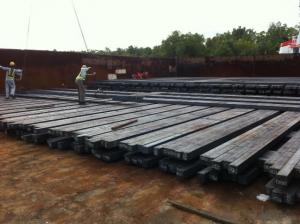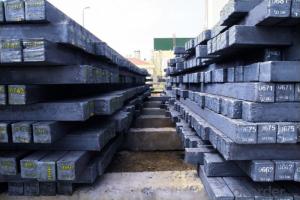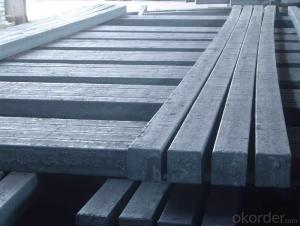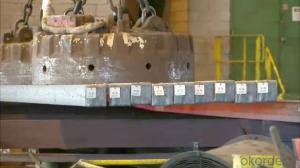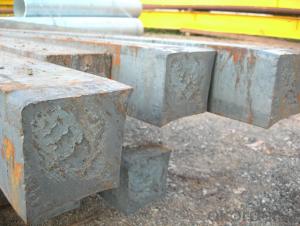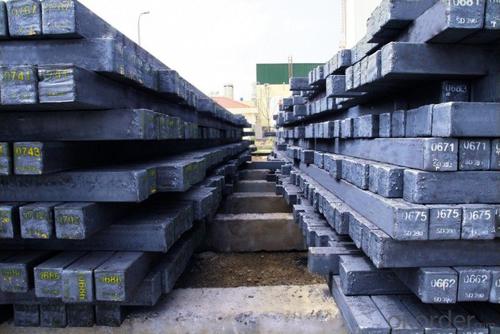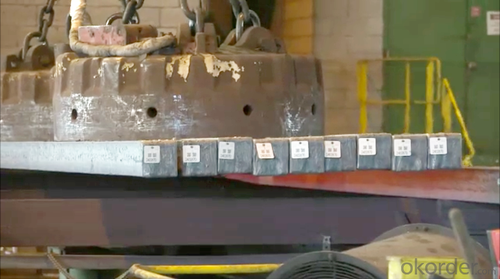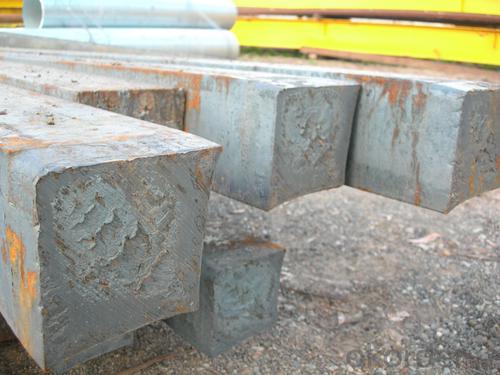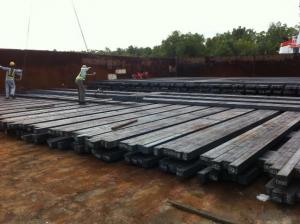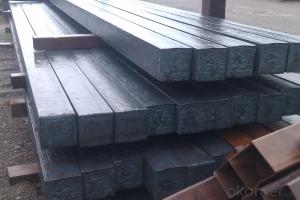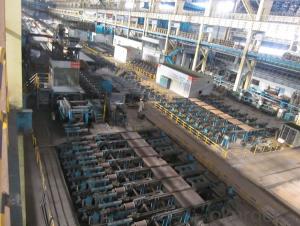Prime quality square alloy steel billet 150mm Q235
- Loading Port:
- Tianjin
- Payment Terms:
- TT OR LC
- Min Order Qty:
- 100 m.t.
- Supply Capability:
- 10000 m.t./month
OKorder Service Pledge
OKorder Financial Service
You Might Also Like
Structure of Prime quality square alloy steel billet 150mm Q235
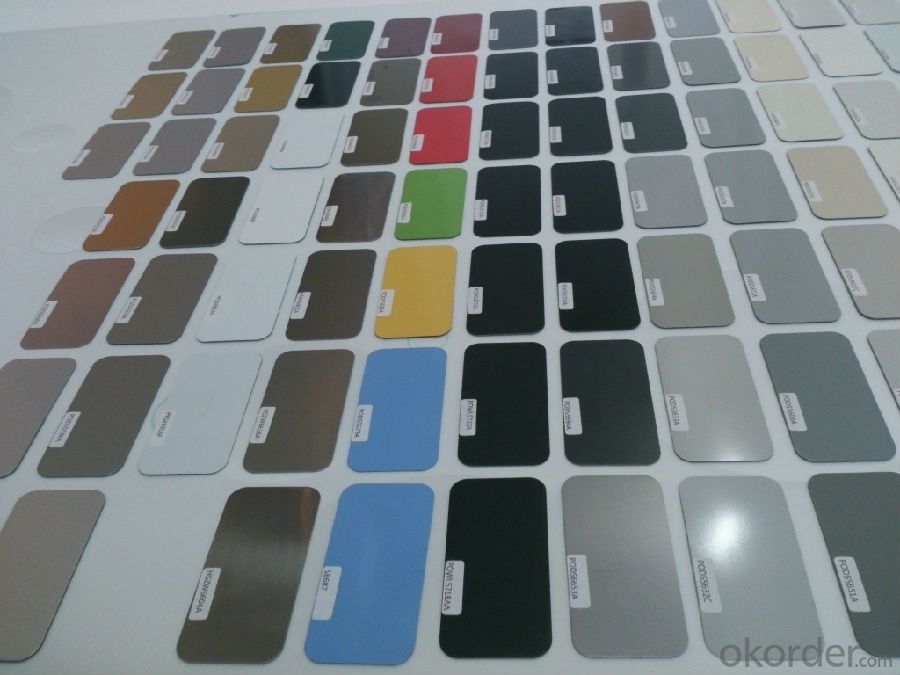
Description of Prime quality square alloy steel billet 150mm Q235
1. Prepainted steel coil is coated with organic layer, which provides higher anti-corrosion property and a longer lifespan than that of galvanized or galvalume steel sheets.
2. The base metals for prepainted steel coil consist of cold rolled, HDGI Steel, electro-galvanized and hot-dip alu-zinc coated steel. The finish coats of prepainted steel coil can be classified into groups as follows: polyester, silicon modified polyesters, polyvinylidene fluoride, high-durability polyester, etc.
3. The production process has evolved from one-coating-and-one-baking to double-coating-and-double-baking, and even three-coating-and-three-baking.
4. The color of the prepainted steel coil has a very wide selection, like orange, cream-colored, dark sky blue, sea blue, bright red, brick red, ivory white, porcelain blue, etc.
5. The prepainted steel coils can also be classified into groups by their surface textures, namely regular prepainted sheets, embossed sheets and printed sheets.

Main Feature of Prime quality square alloy steel billet 150mm Q235
Uncoated CR steel sheet
With the features of in line with the international highest standards in demension and shape, excellent surface finish and properties, the products are mainly used in home appliance and automobile industries.
Galvanized steel sheet(include HDG and EG)
With the features of good corrosion resistance, the products are mainly used in automobile, home appliance, electronics, building and machinery manufacture industries, etc.
Precoated steel sheet
With the features of enviromental protection and good processablility, long lasting surface durability, rich in colors, the products are maily used in building, home appliance and furniture industries, etc.
Applications of Prime quality square alloy steel billet 150mm Q235
Construction
Manufacture anticorrosion, industrial and civil architecture roof boarding, roof grille
Light industries
Home appliance's case, civil chimney, kitchen utensils
Auto industry
Corrosion resistant parts of cars
Agriculture
Food storage, meat and aquatic products' freezing and processing equipment
Commerce
Equipments to store and transport materials, and packing implements

Specifications of Prime quality square alloy steel billet 150mm Q235
Product | Prime quality square alloy steel billet 150mm Q235 |
Material Grade | SGCC / SGCH / DX51D+AZ, etc |
Thickness | 0.6-3.0mm |
Width | 500-1500mm |
Tolerance | Thickness: +/-0.02mm , Width:+/-2mm |
Zinc-coating | Z30-150g/m2 |
Technique | Raw material: Hot rolled steel coil --> Cold rolled_>hot dipped galvalume |
Surface | Dried, Chromated, Unoiled |
Spangle | Regular spangle , small spangle, zero spangle |
ID | 508MM 610MM |
Coil weight | 1-25MT |
Export package | Cardboard inner sleeves, Waterproof paper, galvanized steel covered and steel strip packed |
FAQ of Prime quality square alloy steel billet 150mm Q235
We have organized several common questions for our clients,may help you sincerely:
1. How Can I Visit There?
Our company is located in Tianjin City, China, near Beijing. You can fly to Tianjin Airport Directly. All our clients, from home or aboard, are warmly welcome to visit us!
2. How Can I Get Some Sample?
We are honored to offer you sample.
3. Why choose CNBM?
Our delivery time about 15-20days for standard sizes, if you have other requirements like hardness, quanity and width ,it is about 20-40days. But don't worry we also try our best for the delivery time ,because time longer and our cost is higher.
- Q: What are the safety precautions to be followed while handling steel billets?
- When handling steel billets, it is important to follow several safety precautions to prevent accidents and injuries. Some of the key safety precautions to be followed include: 1. Personal Protective Equipment (PPE): Always wear appropriate PPE such as safety goggles, gloves, and steel-toed boots to protect yourself from potential hazards like sharp edges, flying debris, and heavy objects. 2. Lifting and Handling Techniques: Use proper lifting techniques, such as bending your knees and lifting with your legs, to avoid straining your back or causing musculoskeletal injuries. When moving steel billets, use equipment like forklifts, cranes, or lifting slings to ensure safe and secure handling. 3. Secure Stacking: When storing or stacking steel billets, ensure they are stacked securely and evenly to prevent them from toppling over. Use appropriate storage equipment, such as pallets or racks, and ensure they are in good condition and capable of supporting the weight of the billets. 4. Slips, Trips, and Falls: Keep the area around steel billets clean and free from any obstacles or tripping hazards. Use anti-slip mats or flooring in areas prone to spills or wet conditions. Be cautious of any oil or grease on the floor, as it can create slippery surfaces. 5. Fire Safety: Steel billets can produce sparks when being handled, so it is important to ensure a fire-safe environment. Keep the area clear of flammable materials and have fire extinguishers readily available in case of emergencies. 6. Communication and Training: Communicate with your coworkers about the movement of steel billets to avoid collisions or accidents. Additionally, ensure that all employees receive proper training on safe handling practices and understand the potential risks associated with steel billets. 7. Regular Maintenance and Inspections: Regularly inspect equipment, such as forklifts or lifting slings, to ensure they are in good working condition. Report any damages or malfunctions immediately and do not use faulty equipment. By following these safety precautions, you can minimize the risk of accidents, injuries, and damage to both yourself and the steel billets. It is crucial to prioritize safety at all times when handling steel billets.
- Q: What are the different types of defects that can occur during casting of steel billets?
- During the casting of steel billets, various types of defects may arise, impacting the quality and integrity of the final product. Some commonly encountered defects are as follows: 1. Shrinkage: Shrinkage defects manifest when the metal cools and solidifies unevenly, resulting in voids or shrinkage cavities within the billet. This irregular cooling weakens the structure and diminishes its overall strength. 2. Porosity: Porosity refers to the presence of trapped gas or air bubbles within the billet. This defect can occur due to improper gating or venting, inadequate control of pouring temperature, or the existence of impurities in the molten metal. Porosity can reduce the mechanical properties of the billet and increase its susceptibility to failure. 3. Inclusions: Inclusions denote the presence of non-metallic materials, such as oxides, sulfides, or refractory particles, that become trapped in the billet during casting. These inclusions can weaken the metal, resulting in reduced ductility, increased brittleness, and decreased resistance to fatigue or corrosion. 4. Cold shuts: Cold shuts arise when two streams of molten metal fail to fuse adequately during casting, resulting in a visible line or seam within the billet. Cold shuts can weaken the billet and cause failure under stress. 5. Hot tearing: Hot tearing occurs when the solidifying metal is constrained from contracting, leading to localized cracking or tearing. This phenomenon is typically caused by high thermal stresses or insufficient feeding of the metal during solidification. Hot tearing significantly impacts the structural integrity of the billet. 6. Misruns: Misruns are defects that occur when the molten metal fails to completely fill the mold cavity. This defect can arise due to inadequate pouring temperature, improper gating or venting, or insufficient fluidity of the metal. Misruns result in incomplete, undersized, or malformed billets with reduced mechanical properties. 7. Surface defects: Surface defects encompass surface cracks, scabs, or roughness that may occur during the solidification or cooling process. These defects contribute to increased rejection rates, reduced machinability, and compromised surface finish of the billet. It is of utmost importance to identify and minimize these defects during the casting process to ensure the production of high-quality steel billets with the desired mechanical properties and dimensional accuracy.
- Q: How are steel billets used in the production of oil and gas pipelines?
- Steel billets are essential in the production of oil and gas pipelines as they serve as the initial material for manufacturing these pipelines. Essentially, steel billets are semi-finished steel products that typically have a rectangular or square shape. To manufacture oil and gas pipelines, a series of manufacturing processes are performed on the steel billets. Initially, the billets are heated to high temperatures in a furnace in a process known as billet heating. This heating process increases the malleability of the steel, making it easier to shape. Once the desired temperature is reached, the billets are then passed through a series of rollers to transform their shape into a cylindrical form. This process, called hot rolling, further enhances the mechanical properties of the steel, making it stronger and more durable. Following hot rolling, the steel goes through a process known as quenching and tempering. Quenching involves rapidly cooling the steel to increase its hardness, while tempering is a heat treatment process that reduces the brittleness of the steel, making it less prone to cracking. After these processes, the steel billets are welded together to form the final pipeline. This welding process ensures the integrity and strength of the pipeline, enabling it to withstand the high pressures and harsh environments associated with oil and gas transportation. In conclusion, steel billets play a crucial role in the production of oil and gas pipelines. They serve as the foundational material and undergo various manufacturing processes to transform into durable and high-strength pipes that efficiently transport oil and gas over long distances.
- Q: Can steel billets be used for structural purposes?
- Yes, steel billets can be used for structural purposes. Steel billets are semi-finished steel products that are typically hot-rolled or forged into various shapes, including beams, columns, and other structural components. These billets are commonly used in construction and engineering projects to provide strength, durability, and load-bearing capabilities to structures. Steel billets are often further processed and shaped to meet specific design requirements before being incorporated into the construction process. They are widely utilized in the construction of buildings, bridges, highways, and other infrastructure projects due to their high strength-to-weight ratio and excellent mechanical properties. Additionally, steel billets can be easily welded, making them suitable for various structural applications.
- Q: What are the different testing methods used for steel billets?
- Some of the different testing methods used for steel billets include visual inspection, ultrasonic testing, magnetic particle testing, eddy current testing, and hardness testing.
- Q: How are steel billets rolled into rails?
- Steel billets are rolled into rails through a process called hot rolling. This process involves several steps to transform the steel billets into the desired rail shape. Firstly, the steel billets are heated in a furnace to a temperature of around 1200°C. This high temperature makes the steel malleable and easier to shape. Once the billets reach the desired temperature, they are transferred to a rolling mill. In the rolling mill, the heated steel billets are passed through a series of rolling stands. These stands consist of pairs of large rolls that gradually reduce the thickness and shape of the billets. As the billets pass through each stand, the rolls exert immense pressure on the steel, causing it to elongate and take on the characteristics of a rail. As the billets progress through the rolling mill, they are gradually transformed into rails with the desired dimensions. The rolling process also imparts strength and durability to the rails, making them suitable for use in various applications, such as railway tracks. During the rolling process, water or oil is often used to cool the rolls and prevent them from overheating. This cooling also helps in maintaining the desired temperature of the steel billets as they pass through the rolling mill. Once the steel billets have been rolled into rails, they are cut to the desired lengths and subjected to further processing, such as straightening and heat treatment, to ensure the rails meet the required specifications. In summary, steel billets are rolled into rails through the hot rolling process. This involves heating the billets, passing them through a series of rolling stands, and gradually shaping them into rails with the desired dimensions. The resulting rails are then further processed and prepared for use in various applications.
- Q: How are steel billets used in the manufacturing of automotive components?
- The manufacturing of automotive components heavily relies on steel billets, which serve as essential raw materials. These billets, being semi-finished products, undergo shaping into various forms to create the necessary components. To start with, steel billets are heated to a specific temperature, rendering them malleable and easier to manipulate. Once they reach the desired temperature, they are then placed into molds or dies and subjected to intense pressure to achieve the desired form. This entire process is commonly referred to as forging. When it comes to automotive components like engine parts, gears, axles, and suspension components, high strength and durability are crucial requirements. Steel billets are preferred for these applications due to their outstanding mechanical properties, including high tensile strength, toughness, and wear resistance. Following the forging process, the shaped billets undergo further processing utilizing various techniques such as machining, heat treatment, and surface finishing. These procedures are crucial in ensuring that the components meet the necessary performance standards, dimensional accuracy, and surface quality demanded by automotive manufacturers. The utilization of steel billets in the manufacturing of automotive components offers numerous advantages. Steel is easily accessible, cost-effective, and boasts a high recycling rate, making it an environmentally friendly choice. Additionally, steel's versatility allows for a wide range of component designs and customization options, catering to specific automotive requirements. To conclude, the significance of steel billets in the manufacturing of automotive components cannot be overstated. Their malleability and exceptional mechanical properties make them an ideal raw material for forging processes, enabling the production of high-strength and durable components used across various automotive applications.
- Q: What are the main factors affecting the surface finish of steel billets?
- Several key factors can be attributed to the surface finish of steel billets. Firstly, the quality and cleanliness of the raw materials used in the steelmaking process play a significant role. Surface defects and imperfections can occur if there are impurities or contaminants in the raw materials. Secondly, the manufacturing process's processing parameters directly impact the surface finish. Factors like temperature, speed, and pressure can affect the formation of scale, oxidation, and other surface abnormalities. Excessive scaling can result from high temperatures, while inadequate scale removal can occur due to insufficient temperature control. Furthermore, the surface finish of steel billets is influenced by the type and condition of the equipment used for production. Abrasions, scratches, or other defects in the machinery can transfer onto the billets, affecting their surface quality. Regular maintenance and proper upkeep of the machinery are crucial to ensure a smooth and defect-free surface finish. Moreover, the choice and application of lubricants and coatings during the production process also impact the surface finish. These substances protect the billets from oxidation and reduce friction. However, incorrect application or the use of the wrong lubricant can lead to uneven coating, streaking, or other surface irregularities. Lastly, the handling and storage of steel billets after production can affect their surface finish. Mishandling, improper storage conditions, or exposure to moisture, chemicals, or contaminants can all contribute to surface defects and deterioration. In conclusion, the surface finish of steel billets is influenced by the quality of raw materials, processing parameters, equipment condition, lubricant and coating application, and proper handling and storage. By closely monitoring and optimizing these factors, manufacturers can achieve a high-quality surface finish that meets the desired specifications and requirements.
- Q: What are the main factors affecting the wear resistance of steel billets?
- The wear resistance of steel billets can be influenced by several key factors. Firstly, the composition of the steel plays a crucial role. The presence of specific alloying elements, like chromium, manganese, and molybdenum, greatly enhances the steel's wear resistance. These elements form carbides and other compounds that create a durable and hard surface capable of withstanding abrasion. In addition, the microstructure of the steel is vital in determining its wear resistance. Fine-grained steels tend to have better wear resistance due to their smaller grain size, which provides a more uniform and dense structure, reducing the likelihood of cracks and wear. Heat treatment processes, such as quenching and tempering, can further refine the microstructure and enhance wear resistance. The surface finish also affects wear resistance. A smooth and well-polished surface reduces friction between the steel billet and its surroundings, minimizing wear. Various machining techniques, such as grinding and polishing, can be used to achieve the desired surface finish. Furthermore, the hardness of the steel billet is a significant factor in wear resistance. Hardness is commonly measured using the Rockwell or Brinell scales, and higher hardness values generally indicate improved wear resistance. Heat treatment, alloying, and the addition of hardening agents can all help increase the hardness of the steel billet. Lastly, environmental factors can impact wear resistance. The presence of corrosive substances, high temperatures, or abrasive particles in the working environment can accelerate wear and reduce the lifespan of the steel billet. Implementing appropriate coatings, like chromium plating or thermal spraying, can mitigate these environmental effects and enhance wear resistance.
- Q: What are the different surface treatments for rust prevention in steel billets?
- There are several surface treatments commonly used for rust prevention in steel billets. These include hot-dip galvanizing, electroplating, painting, and applying protective coatings such as zinc-rich primers or epoxy coatings. Each treatment offers varying levels of protection, with hot-dip galvanizing typically being the most effective and durable option.
Send your message to us
Prime quality square alloy steel billet 150mm Q235
- Loading Port:
- Tianjin
- Payment Terms:
- TT OR LC
- Min Order Qty:
- 100 m.t.
- Supply Capability:
- 10000 m.t./month
OKorder Service Pledge
OKorder Financial Service
Similar products
Hot products
Hot Searches
Related keywords
